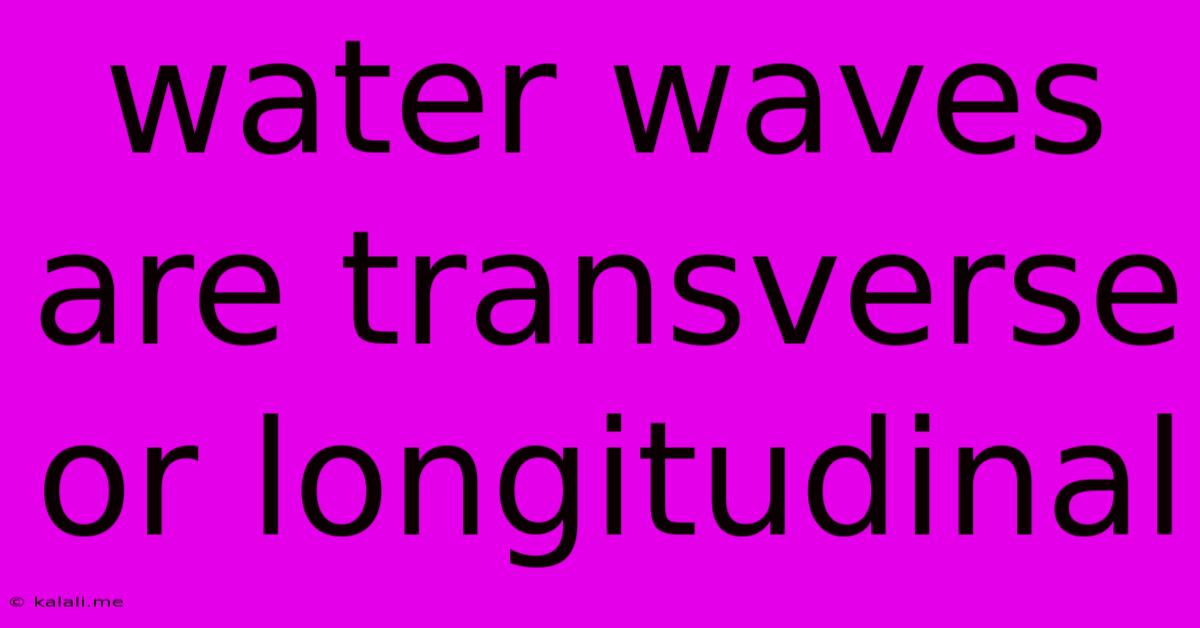Water Waves Are Transverse Or Longitudinal
Kalali
May 20, 2025 · 3 min read

Table of Contents
Water Waves: Transverse, Longitudinal, or Both? Unraveling the Nature of Ocean Motion
Meta Description: Are water waves transverse or longitudinal? This article explores the complex nature of water wave motion, explaining the interplay of both transverse and longitudinal components to create the familiar wave patterns we see in the ocean.
Understanding the true nature of water waves requires moving beyond simple classifications like "transverse" or "longitudinal." While these terms describe fundamental wave types, water waves exhibit a fascinating blend of both, making them a unique and complex phenomenon. Let's delve into the details.
Understanding Transverse and Longitudinal Waves
Before we explore the specifics of water waves, let's briefly review the defining characteristics of transverse and longitudinal waves:
-
Transverse Waves: In transverse waves, the particles of the medium oscillate perpendicular to the direction of wave propagation. Think of a wave on a string – the string moves up and down (perpendicular), while the wave travels along the string's length. Examples include light waves and electromagnetic radiation.
-
Longitudinal Waves: In longitudinal waves, the particles oscillate parallel to the direction of wave propagation. Imagine a sound wave traveling through air – air molecules compress and rarefy along the same axis as the sound wave's direction. Sound waves are a classic example.
The Dual Nature of Water Waves: A Closer Look
Water waves are neither purely transverse nor purely longitudinal. Instead, they exhibit a combination of both types of motion. Consider a water molecule at the surface as a wave passes:
-
Circular Motion: The water molecule doesn't simply move up and down or back and forth. It follows a roughly circular path. This circular motion is a combination of transverse and longitudinal displacements.
-
Transverse Component: The vertical movement of the water molecule, up and down as the wave crest and trough pass, represents the transverse component. This is the most readily observable aspect of water waves, particularly in shallow water.
-
Longitudinal Component: The horizontal movement of the water molecule, forward and backward as the wave progresses, represents the longitudinal component. This component is less visually apparent but plays a significant role, especially in deeper water. The water particles essentially move in a small orbital motion.
Factors Influencing Wave Characteristics: Depth and Wavelength
The relative dominance of the transverse and longitudinal components in water waves depends on two key factors:
-
Water Depth: In shallow water (where the water depth is less than about one-twentieth of the wavelength), the orbital motion of water particles is flattened, and the wave becomes more transverse in nature. The bottom of the ocean bed restricts the vertical movement of water particles.
-
Wavelength: The wavelength (distance between two successive crests or troughs) also plays a crucial role. Longer wavelengths have a greater longitudinal component, while shorter wavelengths exhibit a more pronounced transverse component.
Implications and Applications
Understanding the dual nature of water waves is crucial for various applications, including:
-
Coastal Engineering: Accurate modeling of water wave behavior is essential for designing coastal structures such as seawalls, breakwaters, and harbors.
-
Oceanography: Studying water waves helps scientists understand ocean currents, wave energy, and the complex interactions between the ocean and atmosphere.
-
Ship Design: Understanding wave forces is critical in designing ships and offshore platforms that can withstand the stresses imposed by ocean waves.
In conclusion, classifying water waves as simply transverse or longitudinal is an oversimplification. They are a fascinating example of a wave exhibiting a complex combination of both transverse and longitudinal motion, with the relative importance of each component depending on factors such as water depth and wavelength. This complex interplay is fundamental to understanding the behavior of water waves and their impact on various aspects of our world.
Latest Posts
Latest Posts
-
Why Does My Cat Paw My Face
May 21, 2025
-
Cold Water Not Coming Out Of Faucet
May 21, 2025
-
How To Stop Condensation Bedroom Window
May 21, 2025
-
How Long Does A Glow Plug Last
May 21, 2025
-
How To Get Rid Of Oil Stains On Wood
May 21, 2025
Related Post
Thank you for visiting our website which covers about Water Waves Are Transverse Or Longitudinal . We hope the information provided has been useful to you. Feel free to contact us if you have any questions or need further assistance. See you next time and don't miss to bookmark.